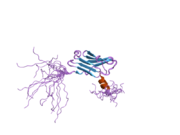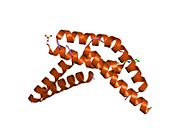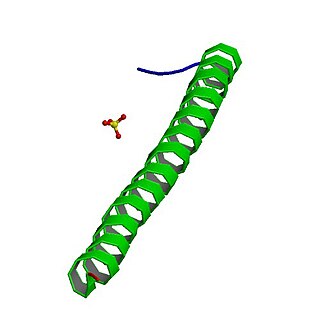
Adenomatous polyposis coli (APC) also known as deleted in polyposis 2.5 (DP2.5) is a protein that in humans is encoded by the APC gene. The APC protein is a negative regulator that controls beta-catenin concentrations and interacts with E-cadherin, which are involved in cell adhesion. Mutations in the APC gene may result in colorectal cancer.

BAG family molecular chaperone regulator 1 is a protein that in humans is encoded by the BAG1 gene.
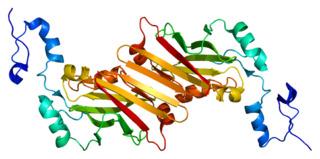
E3 ubiquitin-protein ligase SIAH1 is an enzyme that in humans is encoded by the SIAH1 gene.

Serine/threonine-protein phosphatase PP1-gamma catalytic subunit is an enzyme that in humans is encoded by the PPP1CC gene.

C-terminal-binding protein 1 also known as CtBP1 is a protein that in humans is encoded by the CTBP1 gene. CtBP1 is one of two CtBP proteins, the other protein being CtBP2.

STUB1 is a human gene that codes for the protein CHIP.

Segment polarity protein dishevelled homolog DVL-1 is a protein that in humans is encoded by the DVL1 gene.

S100 calcium-binding protein A6 (S100A6) is a protein that in humans is encoded by the S100A6 gene.

Low-density lipoprotein receptor-related protein 6 is a protein that in humans is encoded by the LRP6 gene. LRP6 is a key component of the LRP5/LRP6/Frizzled co-receptor group that is involved in canonical Wnt pathway.

Gem-associated protein 2 (GEMIN2), also called survival of motor neuron protein-interacting protein 1 (SIP1), is a protein that in humans is encoded by the GEMIN2 gene.

CDC34 is a gene that in humans encodes the protein Ubiquitin-conjugating enzyme E2 R1. This protein is a member of the ubiquitin-conjugating enzyme family, which catalyzes the covalent attachment of ubiquitin to other proteins.
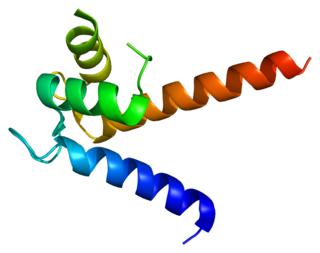
S100 calcium-binding protein P (S100P) is a protein that in humans is encoded by the S100P gene.

E3 ubiquitin-protein ligase SIAH2 is an enzyme that in humans is encoded by the SIAH2 gene.
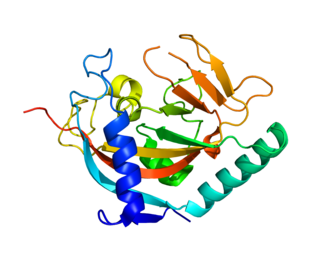
Tankyrase, also known as tankyrase 1, is an enzyme that in humans is encoded by the TNKS gene. It inhibits the binding of TERF1 to telomeric DNA. Tankyrase attracts substantial interest in cancer research through its interaction with AXIN1 and AXIN2, which are negative regulators of pro-oncogenic β-catenin signaling. Importantly, activity in the β-catenin destruction complex can be increased by tankyrase inhibitors and thus such inhibitors are a potential therapeutic option to reduce the growth of β-catenin-dependent cancers.

Retinoblastoma-binding protein 8 is a protein that in humans is encoded by the RBBP8 gene.

Ubiquitin-conjugating enzyme E2 D1 is a protein that in humans is encoded by the UBE2D1 gene.

KH domain-containing, RNA-binding, signal transduction-associated protein 3 is a protein that in humans is encoded by the KHDRBS3 gene.

Tax1-binding protein 3 is a protein that in humans is encoded by the TAX1BP3 gene. This name is in reference to the Tax1 protein of the Human T-cell Lymphotropic Virus (HTLV) which was used to discover Tax1BP3 in a yeast 2-hybrid screen and subsequently verified by co-IP. TIP1, as it is also known, is a PDZ domain containing protein. However, unlike most PDZ domain proteins which act as scaffolds and often contain multiple PDZ domains as well as other protein domains, TIP1 is essentially just the PDZ domain. This has led to the speculation that TIP1 acts as an inhibitor, either acting to separate PDZ binding motifs from their normal targets or simply preventing the protein to migrate away from the cytosol.

Suppressor of G2 allele of SKP1 homolog is a protein that in humans is encoded by the SUGT1 gene.
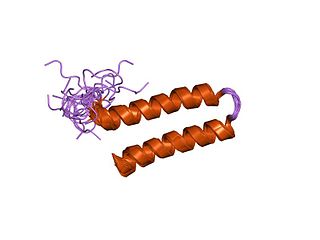
In molecular biology the protein domain, Siah interacting protein N-terminal domain is found at the N-terminal of the protein, Siah interacting protein (SIP). It has a helical hairpin structure with a hydrophobic core which is further stabilised by an arrangement of side chains contributed by the two amphipathic helices. The function of this domain remains to be fully elucidated, but it is known to be vital for interactions with Siah. It has also been hypothesised that SIP can dimerise through this N-terminal domain.




























